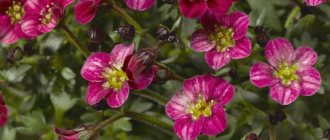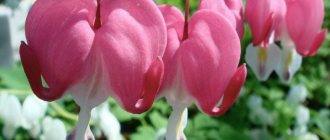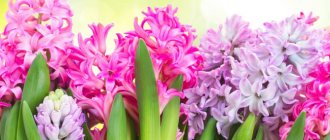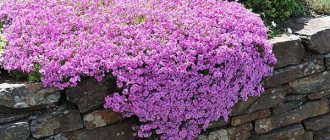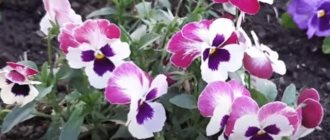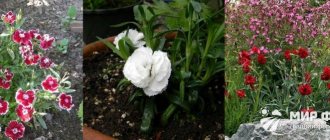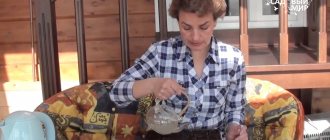Dahlia Figaro is an annual plant that delights gardeners with its magnificent blooms in early autumn. The flower has gained well-deserved popularity due to the unimaginable variety of colors and varieties, the size of the inflorescence and relative unpretentiousness.
Flowerbeds decorated with dahlia Figaro always attract the eye with their brightness and beauty. Knowing some of the features of planting and care, even a novice gardener can achieve excellent results.
Description of the variety and photo
Dahlia "Figaro" is a low-growing plant and is grown from seeds. According to scientists, one of the most important features of the plant is considered to be a rather long flowering period. In addition, the dahlia blooms quite intensely, which cannot but please both the grower himself and his household, as well as neighbors and guests.
- Each dahlia figaro plant forms a fairly compact bush with an almost perfect spherical shape. It reaches a maximum height of 30-35 cm, and the dahlia grows in width by about the same amount.
- The inflorescences of the dahlia Figaro can be double or semi-double, depending on the varietal variety.
- The size of the inflorescences of the dahlia Figaro also varies from 6 to 10 cm.
- The color scheme is quite standard: from white, yellow, to burgundy and purple.
- Inflorescences can appear on plants starting in July and as long as weather conditions allow.
- At temperatures below 0 °C, the Figaro dahlia dies.
The dahlia figaro variety is distinguished by the fact that many inflorescences (up to 12-15 pieces) can form simultaneously on one bush.
Application in landscape
Very often, dahlias "Figaro" are used by landscape designers, because these flowers can be planted on borders or used to create flower beds. Moreover, the plants look great both as single and group plantings.
As for the size and dimensions of the plant, according to the observations of experienced gardeners, as well as data from botanists, the flower can reach 35 centimeters in height, as for the diameter of the flowers themselves, it is quite large, but does not exceed 10 centimeters.
Pros and cons of the variety
The dahlia Figaro has many advantages that allow it to become a real decoration of the garden and local area.
- Early flowering, even when sown from seeds, the first flowers can appear as early as July.
- Unpretentiousness of plants. Dahlias do not require very fertile soil and do not require particularly careful care.
- Flowering is abundant, long lasting and very colorful.
- Dahlia figaro is a wonderful honey plant. By placing flowers close to the vegetable garden, the vegetable yield can be increased due to additional pollination.
- The compactness of the dahlia figaro bushes allows it to be planted not only in flower beds and mixborders on the site, but also in flowerpots in the yard and in pots on balconies and terraces.
There are practically no disadvantages of this dahlia variety. Although for some it may be the short stature of the plants that is a disadvantage.
Reviews of Dahlia Figaro
Natalya Moshkina, 29 years old, Serpukhov
I was always confused by dahlias because of their huge size and the fact that they needed to be tied up. And the Figaro variety is so small and compact that the flowers grow on their own and require virtually no additional care other than watering. And how bright and beautiful they are.
Larisa Gracheva, 49 years old, Saransk
For me, dahlias, like gladioli, are always most associated with the end of summer and September 1, when beautiful bouquets were made from them. But the flowers of this variety of dahlias bloom in the beds already in July and this is very pleasant. Because you can admire the rich colors of these beauties throughout the second half of summer. And then bring several pots onto the terrace and thereby extend the life of the dahlias for another month or two.
Growing from seeds
The seeds are washed and soaked in water for a day and then sown on the 20th of March in a container. Then the soil is prepared with the addition of vermiculite. Prepare the seeds: to do this, they should be placed in a solution of water and aloe juice for 8-9 hours. The solution is prepared in a ratio of 3:1. This treatment is optional, but it will help the seeds develop faster and have a stronger immune system.
- Fill the container with soil, level it, water it and spread the seeds over the surface.
- Sprinkle the soil on top, moisten it with a spray bottle and cover the top with plastic wrap.
- Place in a warm place. When the shoots appear, the film is removed gradually and not immediately so that the shoots adapt. And they put it in a bright place so that they don’t stretch out.
- When 2-3 true leaves appear, I drop them into separate cups. I take the same soil for picking as for seeds. I deepen it down to the cotyledon leaves.
The container is covered with plastic film to maintain the required humidity and placed in a place with a temperature of + 23-25 ° C.
Feeding and pinching
After 10-12, when the seedlings take root, they are fed with complex fertilizer for flowering plants. But since the plant is still small and not so strong, the dosage indicated on the package is reduced by half. Dahlia grows quite quickly, therefore, in order for the plant to grow better in the future, it is necessary to pinch it when more than 6 leaves appear, this is done at the level of 4-5 leaves.
After the 4th leaf, pinch the seedlings. Then it will not stretch out and in the future the bush will be “fluffy”.
Hardening
In April, as soon as the daytime temperature reaches above zero, all the seedlings and dahlias are brought into the greenhouse. During night frosts, cover the seedlings under additional shelter.
When to sow dahlia seeds? In open ground under film in May, or for seedlings in late March - early April in boxes with a mixture of sand and peat (3:1).
Caring for seeds after planting
Immediately after emergence, containers with dahlia seedlings must be placed in the brightest place: on a sunny windowsill or under a special lamp with bright artificial light. Lack of lighting causes dahlia stems to stretch and thin. This can cause weakening or even death of flowers at an early stage of development.
- The film cover is gradually removed over several days.
- When the seedlings have 2 or 3 true leaves, the plants will need to be transplanted into separate pots or large planting boxes.
- When transplanting, young dahlias can be deepened to the first leaves (cotyledons). Also, after transplanting, the flowers are watered moderately.
- Further care of dahlia seedlings does not require any special actions. Plants only need light and moderate watering.
- 10-12 days after transplanting, the seedlings can be fed with a complex fertilizer for flowering plants diluted twice.
To create a lush and voluminous bush, it is recommended to pinch dahlia plants after the formation of the fourth leaf.
Collecting seeds for planting
Dahlia Figaro seeds can be harvested yourself at the end of the season by collecting dried inflorescences. Heads with fully mature seeds are usually dark beige in color. They must be carefully cut in dry and warm weather and placed in a paper envelope. They can be stored in it all winter at room temperature. A few days before sowing, the heads of the inflorescences are pulled out and the dark oblong seeds are manually separated from the plant husk.
True, in this case there is no guarantee that plants grown from seeds will exactly reproduce the maternal properties. If you don’t have your own seeds or want to plant your flower beds with dahlias of certain color shades, you should purchase them in advance in special stores, on the market or online.
If you are confident in the freshness of the purchased seeds, then they do not require any special preparation for sowing.
If you want to once again protect yourself from possible diseases and increase germination, then you can soak dahlia seeds for a day in a warm solution of any immunostimulant: Epin, Zircon, aloe juice and others.
Collection of seed material
Do not forget that an annual plant will not grow in this place next year without seeds. That is why it is necessary to take measures to collect them. To do this, it is recommended to choose the most developed and strong inflorescences on the bush. Tag them. It will take about a month and a half for the seeds to ripen. Collecting seeds will allow you to keep this type of dahlia in your collection. However, you need to know that second-generation flowers may have some differences in color. Complete identity of this trait can be achieved only with the help of tubers.
After waiting for the marked inflorescences to dry, they can be picked. Moreover, it is recommended to collect seeds of the same variety of dahlias from different bushes. To ensure complete drying, the inflorescences must be gutted. After a few days, you can select the seeds. They must have a healthy appearance. Damaged seeds are unlikely to grow into a good plant.
Important! Collect seeds for two years. Even if next year for some reason the flowers do not grow, you will still have a supply of the necessary seeds.
Landing in the ground
Transplantation into open ground should be carried out only in warm weather, but there should be no aggressive sunlight to avoid burns on the plant.
Seedlings are planted in open ground in early June, when the threat of frost has passed, according to the 20*25cm pattern.
Planting should be done in the spring, or more precisely at the end of May. It is worth considering that the size of the hole must correspond to the size of the plant’s root system. Usually a hole is dug about 50 centimeters deep and 45 centimeters wide.
Before planting the plant, a mixture of soil mixed with compost or humus should be placed at the bottom of the hole. Then you need to pour a little soil and form a mound. It is in this mound that the dahlia root system is installed and sprinkled with soil. After planting, you need to water the dahlia well and mulch it.
For mulching, you can use peat, sawdust, hay, compost or just soil. It is necessary to lay out a layer of mulch about 5-6 centimeters in height.
Choosing a landing site
Dahlia loves warmth, so you need to choose an open area for it. Flowers should not only be well warmed by the sun, but also have reliable protection from the cold wind. You need to try to choose a place without drafts. If a dahlia is planted under bushes and trees, it will not bloom well. At the same time, the inflorescences are unlikely to please with their bright colors.
You may be interested in: When to dig up dahlias in the fall: types of flowers When to dig up dahlias in the fall and how to store until planting in the spring? The most favorable days according to the lunar sowing calendar for germinating annual dahlias
As for the soil itself, there are no specific requirements for it. However, looking at the experience of past years, we can say that dahlias show the best growth on loose and slightly acidic soil. It is advisable that it be prepared in advance. This will ensure healthy growth of future flowers. To do this, add humus, sand and turf in equal quantities. This fertilizer will allow the flowers to sprout early and feel good throughout the season.
As a rule, dahlia transplants are tolerated quite well. Having dug a small hole, it is recommended to fertilize it with ash or humus. The process of transplanting to a permanent place should be carried out as carefully as possible. Try not to damage the root system so that the flower does not get sick. It must be taken into account that the bush will grow. Therefore, seedlings are planted at a distance of 20-25 cm from each other. To protect the soil around the flower from drying out, it is recommended to mulch it.
Important! There are often night frosts in May. Therefore, after planting plants in the ground, it is recommended to cover them at night.
Care
“Figaro” are quite unpretentious in terms of care, so they can be bred even in not the most favorable conditions, and can also be used by novice and amateur gardeners. The flowering period of the plant is June-September. Another significant advantage of the plant is its small size. Thus, you can use dahlia even in a limited area of the front garden or vegetable garden. This type of flower includes a large number of varieties that differ not only in external characteristics, but also in internal characteristics.
Caring for the Figaro variety is very simple, as it does not require special care. Basic care will be enough for him: they consist of watering, loosening after watering or rain, mulching and pruning. Pruning is carried out sanitary, that is, limp parts of the plant, dried flowers must be removed, and weeding must also be carried out.
Before the onset of frost, flowers must be covered with some material to protect it from the effects of cold.
A little history
There is a beautiful legend about the origin of dahlias. During a severe cold snap, the fires, kept alive by people with the last of their strength, went out. In place of the last ashes, a flower with petals resembling flames grew. The plant helped people survive difficult times, and remained an eternal symbol of the desire for life.
According to scientific facts, Central and South America are considered the birthplace of dahlias. In their warm homeland, the plants were real giants - reaching up to 6 m in height.
Attention! Dahlia tubers were considered edible (this does not apply to garden crops!).
Flowers were brought to Europe in the 18th century and quickly spread throughout Europe.
Varieties with names and photos
Let's take a closer look at the most popular varieties of dahlia "Figaro".
"Figaro red shades"
Such dahlias will become the real “star” of your site, because it blooms with large, lush and double bright red flowers. Moreover, this color is heterogeneous and has a slight gradient - the middle of the flower is painted in more saturated colors, and towards the edges the color becomes softer and lighter.
This variety is quite low in its botanical characteristics. It is often planted at the entrance to a garden or vegetable garden.
"Figaro yellow"
This variety is considered one of the most unpretentious in the Figaro dahlia line. The color of the flowers varies between different shades of yellow: from light to rich lemon. If you follow all the recommendations for the care and maintenance of the bush, the plant will bloom all summer.
It is important to note that at the time of planting and for some time, the seedlings need to be covered.
"Figaro Violet"
Like other types of plants, this flower got its name due to its bright and unusual colors. So, such a bush will immediately attract your eye, because its flowers have a distinct purple color with a slight crimson tint. In terms of volume, the flowers are quite lush and large in size.
It is important to note that when planting and breeding this variety, you should take into account that it is light-loving, so it should be planted in sunny areas of your garden. If we talk about the composition and structure of the soil, then it must necessarily have a sufficient degree of looseness, and also contain a large amount of nutrients.
"Figaro orange"
The dahlia inflorescences of this variety have a pronounced orange color. At the same time, up to 15 lush flowers can be observed on one bush. The flowering period, like the other varieties described above, occurs in the warm summer season. The shrub is an annual.
There is also a hybrid “Figaro mix”, which can be painted in almost all colors of the rainbow.
Varieties of dahlia Figaro
Dahlia Figaro has many varieties. Thus, if you really want to, you can not just decorate the area with a scattering of various color spots. You can create entire compositions strictly in one color scheme or another.
Figaro mix
This variety, by its very name, speaks of the possibility of planting a variegated flower bed of dahlias of a wide variety of shades without any problems.
The inflorescences are not too large, about 6-8 cm in diameter, but they are entirely double and are distinguished by bright and rich color shades: lilac, carmine, pink, lemon, white, purple. Dahlia Figaro mix flowers are ideal for planting along the front edge of borders, as well as for creating bright spots in the lawn, flower beds or flowerpots.
Figaro Violet Shades
The variety series of these dahlias is distinguished by a more or less saturated purple hue of semi-double inflorescences. The petals usually come in two rows, with the color becoming more intense in the center of each row. And the central part of the flower itself is decorated with a fluffy pompom in a sunny shade.
Inflorescences can reach a diameter of 10 cm and are formed quite early, even before mid-summer. Flowering can continue until September or beyond, depending on the weather conditions of the region in which the plants are planted.
Figaro Yellow Shades
Dahlias of this variety can be called little suns. Because pure yellow flowers, without a single foreign inclusion, adorn low bushes from late June to September. The inflorescences are quite dense and lush, and there are so many of them that often the greenery is not noticeable behind the flowers.
The variety is very unpretentious and in more southern regions it can even be propagated by direct sowing in the ground in May. In case of possible frosts, young plants are covered with non-woven material on temporary supports.
Figaro White Shades
This type of dahlia figaro does not have the largest inflorescences. Usually they reach a diameter of only 7-8 cm. But their relatively small inflorescence size is more than made up for by their fluffy terry. Exquisite petals of a soft white hue are replaced by a bright yellow center, noticeable even from afar. Against the background of a thick and rich herbal shade of greenery, the flowers look very attractive and create a festive mood.
The bushes are small in height, up to 35 cm, like all other dahlias of this variety.
Figaro Red Shades
This variety of dahlia has a lush yellow core that stands out brightly against the background of the scarlet or carmine-red hue of the petals. It not only contrasts interestingly with the petals, but also creates a peculiar light reflection on the petals over the entire surface of the inflorescences.
In general, dahlias of this variety look very bright and formal, and can decorate the entrance to a house or property. In all other respects, these dahlias do not differ much from other varieties; flowering is quite early and long-lasting. Due to their small size, the bushes themselves should be planted in the foreground so as not to be obscured by other, larger flowers.
